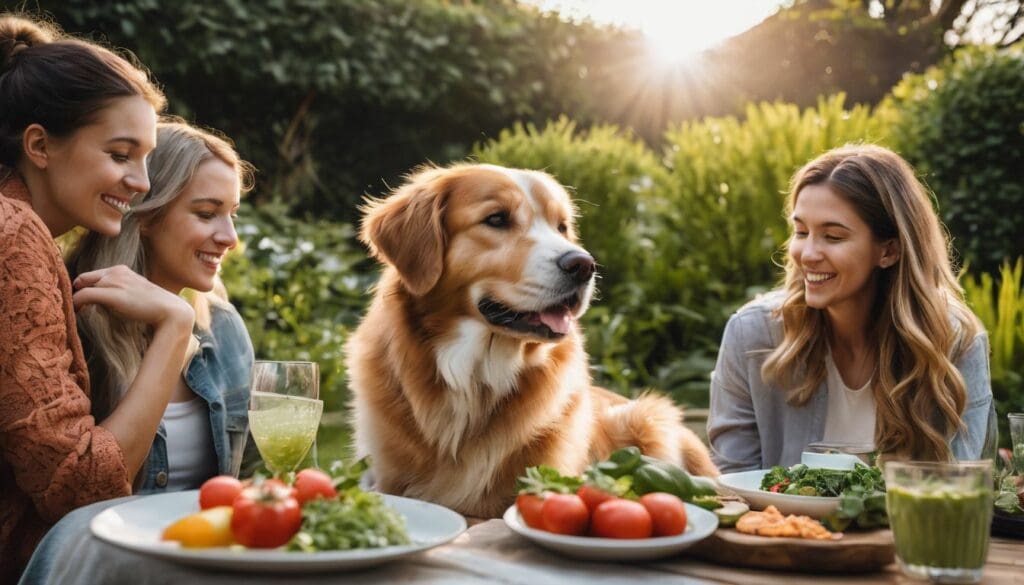Are you puzzled about what’s really in your pet’s food bowl? Every year, more pet owners are choosing organic options for their furry friends. Our guide will unravel the mystery of organic pet food and how it could benefit your companion.
Dive in to feed your curiosity!
Key Takeaways
- Organic pet food must comply with USDA standards and be free of synthetic pesticides, herbicides, and fertilisers to carry the ‘organic’ label.
- Certifications such as the USDA Organic Seal help shoppers identify true organic products; it’s important to read labels for these certifications when buying pet food.
- While organic pet food offers multiple health benefits, it can be more expensive and have fewer flavour options due to its natural ingredients.
- Different types of organic pet foods are available including dry kibble, canned food, raw diets, freeze-dried options and homemade meals that cater to various dietary needs.
- Choosing organic means supporting environmentally sustainable practices in farming while providing pets with a diet that contributes to their overall wellbeing.
Understanding Organic Food
Organic food is grown and processed without the use of synthetic pesticides, herbicides, or fertilisers. It is regulated at state-level and must comply with USDA organic standards.
Definition of Organic
The term ‘organic’ refers to the way farmers grow and process agricultural products like fruits, vegetables, grains, dairy products and meat. Organic farming practices encourage soil and water conservation while reducing pollution.
Farmers who grow organic produce and meat avoid using conventional methods to fertilise, control weeds or prevent livestock disease. For livestock raised for meat, eggs, and dairy products to be labelled as organic must have access to the outdoors and be fed organic feed.
They are not given antibiotics, growth hormones, or any animal by-products.
When it comes to pet food bearing the USDA organic seal, you can trust that at least 95% of its contents were produced organically. This means synthetic pesticides-free ingredients; herbicide-free production methods ensure a cleaner final product for your beloved pets’ consumption.
In contrast with traditional agriculture approaches where chemicals may prevail, organic regulations strictly limit unnatural substances in food items meant for your furry friends’ optimal health—matching human food regulations in multiple aspects while specifically tailoring requirements under AAFCO standards dedicated towards pet food compliance.
State-Level Organic Regulations
State-level organic regulations vary across the United States, with each state having its own set of standards and guidelines for organic pet food. These regulations cover aspects such as the use of synthetic pesticides, herbicides, and fertilisers in the production of organic pet food.
The aim is to ensure that pet food marketed as organic meets specific criteria for optimal health benefits for pets while aligning with environmentally conscious practices.
Certification bodies oversee the enforcement of these state-level regulations to ensure that organic pet food adheres to the defined standards. Additionally, some states may have additional requirements beyond those set by national authorities, such as Non-GMO or sustainable sourcing guidelines.
USDA Organic Standards
The USDA organic standards ensure that pet food labelled as organic meets specific requirements. The standards prohibit the use of synthetic pesticides, herbicides, and fertilisers in the production of organic ingredients.
Additionally, they outline requirements for animal welfare, processing methods, and non-GMO ingredients to ensure that organic pet food adheres to sustainable practices throughout its production.
By following these standards, manufacturers can obtain certification for their products as USDA certified organic. This provides reassurance to environmentally conscious individuals looking for pet food options that support conservation and environmental health.
Is Organic Pet Food Better?
Organic pet food is believed to offer numerous benefits, such as being free from synthetic pesticides, herbicides, and fertilisers that can harm pets. However, there may also be potential cons to consider when choosing organic pet food for your furry friends.
Benefits of Organic Pet Food
Organic pet food provides optimal health for pets. It supports their well-being and longevity.
- Organic pet food is natural and free from synthetic pesticides, herbicides, and fertilisers. This ensures that pets are consuming clean, chemical-free nutrition.
- It promotes holistic pet nutrition, offering a sustainable diet that is non-GMO and ethically sourced. This supports conservation efforts and environmental sustainability.
- Certified organic pet food ensures a clean-label, human-grade diet for pets, providing them with whole food options that promote balanced meal plans.
- By opting for organic pet treats, owners can offer their pets raw feeding options which contribute to healthy pet food choices.
Potential Cons
While organic pet food offers numerous benefits, there are some potential cons to consider. Firstly, organic pet food tends to be more expensive than conventional options due to the higher cost of sourcing and producing natural ingredients.
Additionally, because organic pet food avoids synthetic pesticides and herbicides, it may have a shorter shelf life compared to non-organic alternatives. Another factor is that limited availability of certain organic ingredients might lead to fewer flavor options for your pets.
It’s important for environmentally conscious individuals supporting conservation and environmental sustainability to weigh these potential drawbacks against the overall benefits when considering organic pet food for their furry companions.
What Makes Pet Food Organic?
Organic pet food is made from ingredients that are grown and processed without synthetic pesticides, herbicides, or fertilisers. To be considered organic, pet food must meet certain certification requirements and can come in various types such as dry kibble, wet food, or raw feeding options.
Organic Certification Requirements
- Meeting USDA Organic Standards, ensuring that the pet food is free from synthetic pesticides, herbicides, and fertilisers.
- Using ethically sourced ingredients that support sustainable farming practices.
- Adhering to non – GMO standards to provide natural, holistic pet food options.
- Implementing clean label practices to offer transparent and chemical – free pet nutrition.
- Providing whole food pet diet options that promote health and balanced meal plans for pets.
Types of Organic Pet Food
After understanding the organic certification requirements, it’s important to be aware of the different types of organic pet food available. Here are the various options to consider:
- Organic dry pet food: This type of pet food is made using certified organic ingredients and does not contain any synthetic additives or preservatives.
- Organic canned pet food: Canned organic pet food is an option that provides a convenient and nutritious meal for pets, often made with high-quality organic meats and vegetables.
- Organic raw pet food: Raw organic pet food consists of uncooked meats, bones, and vegetables that are free from antibiotics, hormones, and GMOs.
- Organic freeze-dried or dehydrated pet food: These types of organic pet foods undergo minimal processing to retain the nutrients and are a convenient option for pet owners.
- Organic homemade pet food: Some environmentally conscious individuals prefer to prepare their own organic pet food using human-grade ingredients sourced from local organic farms.
- Specialty diets: There are specialised organic pet foods available for pets with specific dietary needs such as grain-free, gluten-free, or limited ingredient diets containing high-quality, natural ingredients.
- Treats and supplements: Treats and supplements in the form of chews, biscuits, and powders are also available in organic options to add variety to a pet’s diet while maintaining their health.
How to Identify Organic Pet Food
When shopping for organic pet food, it’s important to read the labels carefully and look for certifications from reputable organisations. These can help you identify pet food that meets strict organic standards and is free from synthetic pesticides, herbicides, and fertilisers.
Reading Labels
- Look for the “USDA Organic” seal or “Certified Organic” label on the packaging, ensuring that the product meets strict organic standards without synthetic pesticides, herbicides, or fertilisers.
- Check for non – GMO (Genetically Modified Organism) certification to ensure the ingredients are free from genetically modified organisms.
- Read the ingredient list – prioritise natural, ethically sourced ingredients and avoid chemical additives or preservatives.
- Ensure that the label indicates a sustainable and environmentally friendly approach to production and sourcing.
- Verify if the pet food follows a clean label approach, indicating a transparent and minimally processed product.
Recognising Certifications
To identify organic pet food, look for recognisable certifications on the packaging. Always check for the following certifications to ensure that the pet food meets organic standards:
- Look for the USDA Organic Seal, which ensures that the product has been certified as meeting strict organic standards set by the United States Department of Agriculture.
- Check for certifications from reputable organisations such as the Soil Association, which is a widely recognised certification body in the UK ensuring organic integrity.
- Seek out products with the Non – GMO Project Verified seal, guaranteeing that the pet food is free from genetically modified organisms.
- Consider pet foods certified by independent organisations like A Greener World, known for their rigorous animal welfare and environmental sustainability standards.
- Familiarise yourself with logos or labels indicating ethical sourcing and environmentally friendly practices to support companies committed to sustainable pet food production.
Conclusion
In conclusion, organic pet food offers numerous benefits for your furry friend. Reading labels and recognising certifications are essential steps to identify organic pet food. Choosing natural, synthetic pesticide-free, herbicide-free, fertiliser-free options can lead to a healthier and more sustainable diet for your pets.
Making informed choices about their nutrition can positively impact the environment as well as their overall wellbeing.
FAQs
1. What exactly is organic pet food?
Organic pet food is made from ingredients that are free from synthetic pesticides, herbicides, and fertilisers, ensuring a natural and chemical-free diet for pets.
2. Why should I choose organic food for my pet?
Choosing organic pet food benefits your furry friend by offering them a healthy option with clean label ingredients that are non-GMO and often human-grade.
3. Are there different types of organic foods available for pets?
Yes, there’s a variety of options including raw feeding plans, balanced meal formulations and ethically sourced products to cater to the sustainable diet needs of your pet.
4. Can organic pet food really impact my pet’s health?
Absolutely! Feeding your pet with natural, fertiliser-free nutrition can lead to better health outcomes due to fewer chemicals in their meals.
5. Is natural or organic pet food the same thing as GMO-free?
Yes! Natural or non-GMO refers to foods that haven’t been genetically modified, which aligns with the principles of producing clean label and fertiliser-free Organic Pet Food.





